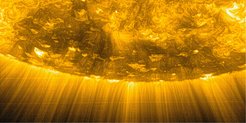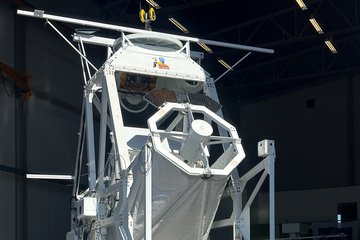Diagnostics of coronal dynamics and heating for the MUSE mission
Spectroscopic and imaging data from observations and synthesized from 3D MHD models of the Solar corona
The Sun is surrounded by a hot outer atmosphere, the corona. Understanding the dynamics and the heating of the plasma around our host star is one of the most interesting problems in stellar astrophysics. While the surface seen in visible light, the photosphere is less than 6000 K hot, the temperatures in the corona reach more than a million K, in energetic events called flares even up to 10 million K or more. This PhD project aims to (better) understand the processes and the complex structure (as seen in the following figure from Solar Orbiter) of the solar corona and to employ novel techniques the analysis of data from models and observations.

Currently we study the corona mostly using imaging instruments in the extreme ultraviolet (EUV) and with spectrometers using a single slit giving access to, e.g., plasma velocities or turbulent motions. The new space observatory MUSE (MUltislit Solar Explorer) will combine these two types of instruments through an array of parallel spectrograph slits. This will provide a new view of coronal heating and dynamics because it will provide the information of the detailed plasma state over a large field of view simultaneously.
The thesis work in this project provides the unique possibility to combine the current scientific study of the coronal dynamics and heating with the preparation for the new data products to be expected from MUSE. In the project the student will investigate spectroscopic and imaging data from observations and synthesized from 3D MHD models to investigate the processes that drive the solar corona. For this, recent data from the Solar Orbiter mission of ESA and NASA will be combined with EUV spectra from the Hinode space observatory. The results of these observations shall be compared to corresponding data synthesized from modern 3D MHD models with the MURaM code. These data will be used to forward calculate the data as expected from MUSE. Because the line profiles to be recorded through the different slits of MUSE, there will be a spectro-spatial confusion of the MUSE data that requires correction. Procedures for this disambiguation do exist already, but the speed for this deconvolution needs to be increased, most probably though machine learning techniques.
This PhD project will be funded through DLR and will be embedded into the work of the MUSE team at MPS. Naturally, not all aspects of the complex undertaking mentioned above can be addressed in a single PhD project. Depending on the qualification and interests of the prospective student, together with the team we will select the most appropriate tasks within the MUSE efforts at MPS.












